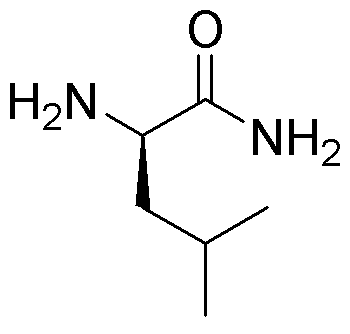D-Leucine amide is widely utilized in research focused on:
- Pharmaceutical Development: This compound serves as a building block in the synthesis of various pharmaceuticals, particularly in the formulation of peptide-based drugs that target specific biological pathways.
- Protein Engineering: D-Leucine amide is used to modify protein structures, enhancing their stability and activity, which is crucial in biotechnological applications and enzyme design.
- Food Industry: It acts as a flavor enhancer and nutritional supplement, appealing to health-conscious consumers looking for natural amino acid sources to improve their diets.
- Cosmetics: The compound is incorporated into skincare formulations for its moisturizing properties, helping to improve skin texture and hydration.
- Research in Metabolism: D-Leucine amide is studied for its role in metabolic pathways, providing insights into muscle growth and recovery, which is beneficial for sports science and nutrition research.
General Information
Properties
Safety and Regulations
Applications
D-Leucine amide is widely utilized in research focused on:
- Pharmaceutical Development: This compound serves as a building block in the synthesis of various pharmaceuticals, particularly in the formulation of peptide-based drugs that target specific biological pathways.
- Protein Engineering: D-Leucine amide is used to modify protein structures, enhancing their stability and activity, which is crucial in biotechnological applications and enzyme design.
- Food Industry: It acts as a flavor enhancer and nutritional supplement, appealing to health-conscious consumers looking for natural amino acid sources to improve their diets.
- Cosmetics: The compound is incorporated into skincare formulations for its moisturizing properties, helping to improve skin texture and hydration.
- Research in Metabolism: D-Leucine amide is studied for its role in metabolic pathways, providing insights into muscle growth and recovery, which is beneficial for sports science and nutrition research.
Documents
Safety Data Sheets (SDS)
The SDS provides comprehensive safety information on handling, storage, and disposal of the product.
Product Specification (PS)
The PS provides a comprehensive breakdown of the product’s properties, including chemical composition, physical state, purity, and storage requirements. It also details acceptable quality ranges and the product's intended applications.
Certificates of Analysis (COA)
Search for Certificates of Analysis (COA) by entering the products Lot Number. Lot and Batch Numbers can be found on a product’s label following the words ‘Lot’ or ‘Batch’.
*Catalog Number
*Lot Number
Certificates Of Origin (COO)
This COO confirms the country where the product was manufactured, and also details the materials and components used in it and whether it is derived from natural, synthetic, or other specific sources. This certificate may be required for customs, trade, and regulatory compliance.
*Catalog Number
*Lot Number
Safety Data Sheets (SDS)
The SDS provides comprehensive safety information on handling, storage, and disposal of the product.
DownloadProduct Specification (PS)
The PS provides a comprehensive breakdown of the product’s properties, including chemical composition, physical state, purity, and storage requirements. It also details acceptable quality ranges and the product's intended applications.
DownloadCertificates of Analysis (COA)
Search for Certificates of Analysis (COA) by entering the products Lot Number. Lot and Batch Numbers can be found on a product’s label following the words ‘Lot’ or ‘Batch’.
*Catalog Number
*Lot Number
Certificates Of Origin (COO)
This COO confirms the country where the product was manufactured, and also details the materials and components used in it and whether it is derived from natural, synthetic, or other specific sources. This certificate may be required for customs, trade, and regulatory compliance.


